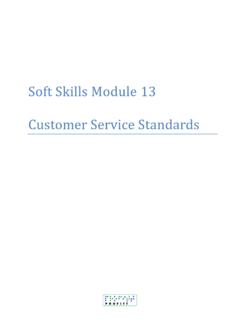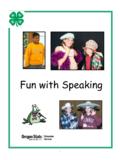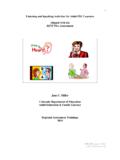Transcription of Soft Skills Module 5 Effective Communication: Listening ...
1 Soft Skills Module 5 Effective communication : Listening , Speaking, Writing, InterpretingPROFITT Curriculum Module # 5 Effective communication Soft Skills 5-1 Soft Skills Module 5 Effective communication : Listening , Speaking, Writing, Interpreting Summary Goal: Equip students with practical, Effective communication Skills Listening , speaking, writing and interpretation. SMART Objectives: Specific, Measurable, Achievable, Realistic, and Time-sensitive By the end of this Module , students should be able to: Objective : Be an active listener, Listening with comprehension and understanding. Objective : Speak clearly with efficiency and success in delivering the message. Objective : Assess general non-verbal behaviors and respond effectively. Objective : Interpret written information and respond suitably.
2 Objective : Write so others understand. Instructor: Delivery Method(s): Discussion; group activities, individual activities Length: Six Lessons Total of 8 hours plus additional independent time for written activities and practice Any Applicable Business and/or Soft Skills ? Writing a Business Plan Selling Secrets Gaining the Customer Satisfaction Edge Targeting New Markets Corresponding NLS Lesson #? Take Away Message(s): The intent of this Module is to assist students with communication Skills that will serve them well as braille transcribers and micro-entrepreneurs in their communities. PROFITT Curriculum Module # 5 Effective communication Soft Skills 5-2 Instructor Preparation Title of Module : Effective communication : Listening , Speaking, Writing, Interpreting Instructor: This Module is one of practicality and application.
3 During these and all subsequent lessons, encourage students to practice and apply Effective communication Skills in Listening , speaking, writing and interpreting (printed materials, non-verbal behaviors, etc.). All activities are based on the elements of Effective communication applied to starting and operating a microenterprise. Agenda topics to be covered in the Module and length of each item Topic: communication Time Allotted: 8 hours A. communication (45 minutes) B. Active Listening ( hours) C. Speaking Clearly (30 minutes) D. Non-Verbal Behaviors ( hours) E. Interpretation of Written Information (30 minutes) F. Clear Writing (45 minutes) G. Creating a Master Checklist (30 minutes) Materials & Supplies items needed in order to carry out the agenda and classroom activities 1.
4 Handouts: Personal Listening Assessment ( ), Listening Categories ( ), Impressions ( ), Focus Your Message ( ), Non-Verbal communication - Messages without Words ( ), Observation Guide for Speaking Clearly ( ), Emails Mnemonics Strategy ( ), Social Media Do s and Don ts ( ), Writing Practice ( ) 2. Foam ball/soft koosh ball 3. One minute timer/stop watch or clock 4. Small box without a lid PROFITT Curriculum Module # 5 Effective communication Soft Skills 5-3 5. Slips of paper a. (for the 1 s) You are the paraphraser your job is to see how long you can keep your partner engaged in a conversation through active Listening and by paraphrasing; remember you can only do paraphrasing do not participate in the discussion. b. (for the 2 s) You are the storyteller choose one of the conversation topics on the flip chart/board and talk about it.
5 6. Flip chart/pad with markers or board/markers for instructor 7. Video: 5 Things Not to Do on Social Media ( ) Classroom Preparation steps to follow when setting up the learning environment 1. Students configured to facilitate group discussion as well as dyads and triads as needed 2. Wrting paper and pencils for students 3. Flip chart/pad with markers or board/markers for instructor 4. Access to computer word processing 5. Adequate room to form a circle (standing up) 6. Ability to have chairs back-to-back and then face-to-face for an activity 7. TV or computer and screen ready to show the supplemental video PROFITT Curriculum Module # 5 Effective communication Soft Skills 5-4 Curriculum Content A. communication (45 minutes) Objective : Be an active listener, Listening with comprehension and understanding.
6 CONTENT PRESENTATION AND LEARNER PARTICIPATION Begin this series of lessons with the following discussion: What is communication ? Have the group brainstorm answers/definitions. Facilitate by asking other questions that eventually lead students to responses that include Listening , speaking, writing, and interpreting (non-verbal) Skills . Write responses on chart paper . How do we communicate in today s world? Responses should include phone (cell and landline), social media, internet, newspapers, radio, television, verbal, etc. Write responses on chart paper . How many of these forms of communication will you need to use in your home-based business? Put a checkmark next to those students identify. Introduce the following basic questions to consider when practicing and applying Effective communication : What is the intent or purpose of the communication ?
7 What is or needs to be communicated? To whom is the information being communicated? What do you know about the individuals receiving the information? How are you going to communicate the information? B. Active Listening ( hours) Objective : Be an active listener, Listening with comprehension and understanding. PROFITT Curriculum Module # 5 Effective communication Soft Skills 5-5 The target of the lesson is to assist students in becoming better active listeners resulting in higher levels of comprehension and understanding of customer needs. PREINSTRUCTIONAL ACTIVITIES Have students do the Personal Listening Assessment ( ); a self-assessment of their Listening Skills and behaviors give the answers but do not explain them; tell students the answers will become clear as they work through the lessons.
8 Answers: , , , , , , Answers: 8-15 are personal/individual. CONTENT PRESENTATION AND LEARNER PARTICIPATION Pose the question: What is the difference between Listening and hearing? Activity This activity helps students understand the complexity of Listening . Write three questions on the chart paper or board so everyone can see them, and make sure they pertain to the students and will elicit some variety in responses; sample questions might be: How did you hear about the braille transcription program? What are your goals for the future? What was your favorite subject or class in school? If you could go anywhere, where would it be? What type of books do you like to read? Have students stand in a circle. The instructor holds a small soft foam ball or squishy (koosh works nicely), says his/her name and answers one of the questions.
9 PROFITT Curriculum Module # 5 Effective communication Soft Skills 5-6 The instructor tosses the ball to a student who says his/her name and answers one of the questions. This process continues until everyone has introduced themselves and answered one question. Students return to their seats and write down peer students names and any corresponding information they can recall. Close the activity with a discussion of the ease and/or difficulty of concentrating and focusing, Listening and remembering throughout the activity. Activity This activity promotes an awareness of what it feels like to listen to others and be listened to. Ask students to generate a few conversation topics. Write them on chart paper or the board. Introduce the Listening box (small box, easy to hold, preferably no lid) as well as the timer/stop watch or clock which times each student for one minute.
10 Students can speak when they are holding the box; otherwise, they must listen and remain silent. The instructor puts the box on the floor and allows any student to begin by picking up the box. The student holding the box gives his/her opinion about one of the topics written on the chart paper or board (opinions must be directed toward the earlier generated topics, not new ones) within the one minute time period. The student speaking, when finished passes the box to someone else; at that time the new student begins to speak for his/her minute about one of the topics on the chart paper /board. Proceed until all have spoken. After all have spoken, ask students to sit down and journal about their thoughts and feeling about the exercise; how did it feel to listen to someone else? How much can they recall?






